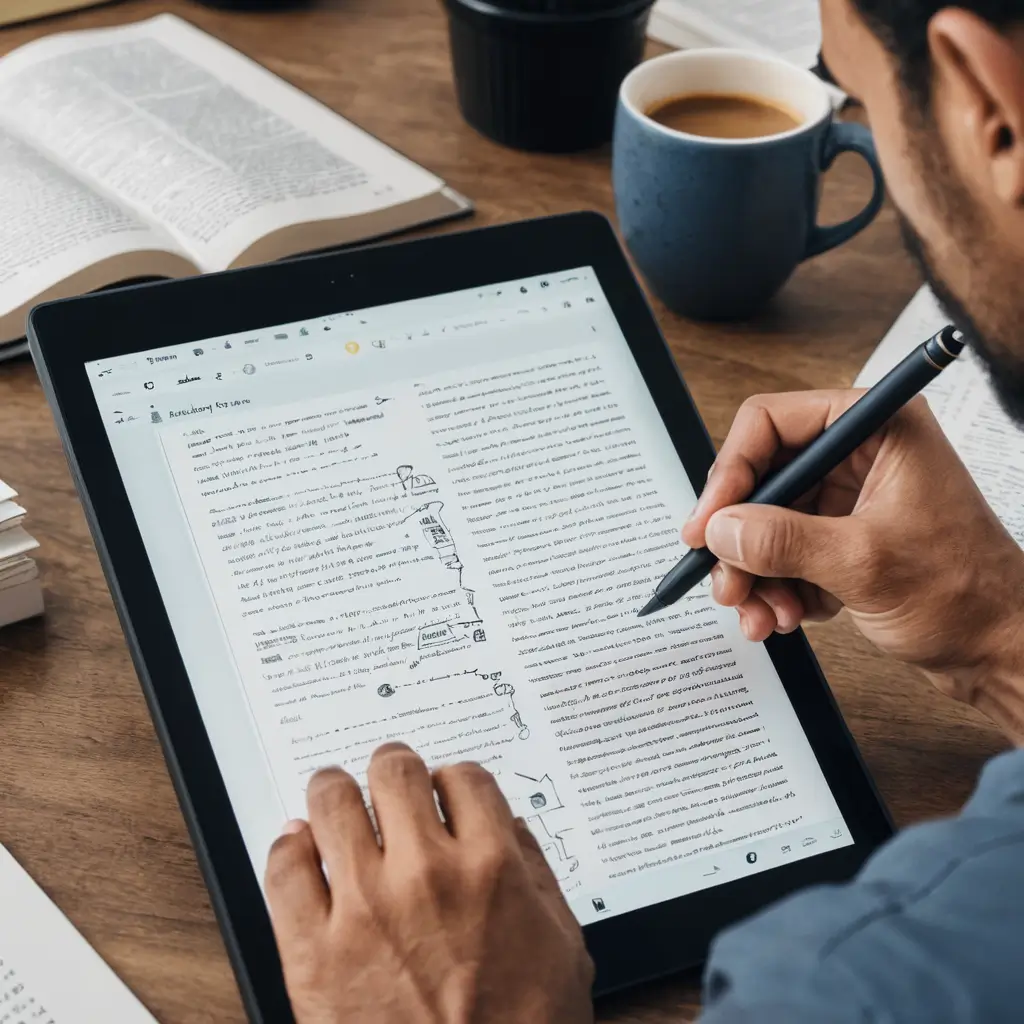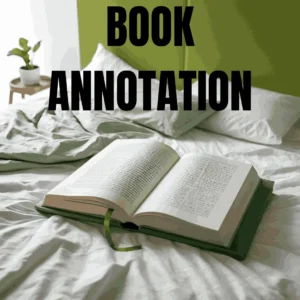Did you know that readers who annotate their books retain up to 80% more information? Book annotation is a powerful tool that transforms the reading experience by enhancing comprehension, deepening engagement, and improving retention of key ideas. For avid readers, annotating a book not only adds value but also creates a personal dialogue with the text, helping to connect more deeply with the material.
In this post, I’ll share five effective book annotation techniques that can help you get more out of your reading. Whether you’re a student, a book club member, or simply someone who loves to read, these techniques will take your reading experience to the next level.
1. Marginalia: The Art of Writing in the Margins
Marginalia is one of the oldest and most effective forms of book annotation. It involves jotting down notes, reflections, or questions directly in the margins of your book. Think of it as having a conversation with the author — you respond to ideas, highlight what resonates with you, and question what you don’t understand.
Why It Works:
Marginalia allows for an active reading experience. As you engage with the text, you can explore your own thoughts and build a deeper connection with the material.
Tips for Effective Marginalia:
- Keep it brief: Margins can be small, so be concise with your notes. Use abbreviations if necessary, but ensure they remain understandable when you revisit them later.
- Ask questions: Challenge the text by writing questions about unclear ideas or alternative perspectives. This encourages critical thinking and deeper analysis.
- Use symbols: Develop a personal system of symbols to highlight key points (e.g., stars for important ideas, question marks for confusing sections).
Experience: When I first read Gabriel García Márquez’s One Hundred Years of Solitude, I used marginalia to track the complex relationships between characters. Without those quick notes, I would have struggled to remember the intricate details and recurring themes in the novel.
2. Color-Coding: Creating a Visual Roadmap
If you’re a visual learner, color-coding your annotations can be a game-changer. Assigning different colors to various themes or elements in the book helps you quickly identify important sections when revisiting the material. This technique is especially useful in nonfiction, where you may want to categorize information into topics.
Why It Works:
Color-coding provides structure and clarity to your annotations. By visually organizing the content, you make it easier to reference and review key points later.
Tips for Color-Coding:
- Create a key: Before starting, establish a color code system. For example, use yellow for important quotes, blue for character development, and pink for plot points.
- Be consistent: Stick with your chosen color scheme throughout the book to avoid confusion later.
- Use pens or highlighters: Make sure to use non-bleed highlighters or colored pens that won’t damage the pages or bleed through.
Anecdote: I recently read The Lean Startup by Eric Ries, and I used color-coding to distinguish between actionable advice, case studies, and conceptual ideas. By doing so, I was able to go back and quickly find specific strategies when I wanted to implement them in my own business.
3. Post-It Notes and Tabs: Portable, Non-Permanent Annotations
Sometimes, you may not want to mark up your books, especially if they’re rare, expensive, or borrowed. In these cases, using post-it notes or colored tabs can be a great alternative. These portable tools allow you to annotate without permanently altering the book.
Why It Works:
Post-it notes give you flexibility. You can write longer thoughts than you might in the margins, and you can easily remove or rearrange them as needed. Tabs help you quickly locate important pages without having to skim through the entire book again.
Tips for Using Post-It Notes:
- Summarize key points: Use post-it notes to summarize whole chapters or sections and stick them at the beginning or end of each chapter.
- Use tabs for navigation: Color-coded tabs can mark important sections or chapters for quick reference. For example, green tabs for chapters with essential insights, and yellow tabs for discussion points.
- Layer your notes: You can stack multiple post-its on a single page if necessary, but be sure to keep them organized.
Experience: In a recent book club, I used post-it notes to jot down thoughts on particular passages of The Night Circus by Erin Morgenstern. During the discussion, the notes helped me recall significant moments in the book, making my contributions to the conversation more insightful.
4. Annotation Apps and Digital Tools: The Future of Book Annotation

For those who prefer reading on a Kindle, tablet, or other e-readers, annotation apps offer a wealth of features that traditional paper books can’t match. Apps like Kindle, Notion, Evernote, and PDF editors allow you to highlight, add notes, search for specific phrases, and even share annotations with others.
Why It Works:
Digital annotation allows for a seamless reading experience. You can quickly highlight sections, add comments, and organize notes in a way that’s easy to retrieve later. Plus, digital notes are searchable, which is incredibly helpful when revisiting long texts.
Tips for Digital Annotation:
- Highlight key points: Use the highlight function in your app to mark important passages, quotes, or data.
- Add detailed notes: Write longer notes or summaries without the worry of running out of space.
- Sync across devices: Many apps allow you to sync annotations across your phone, tablet, and computer, so you can access your notes wherever you are.
Anecdote: While working on a research paper, I used Kindle’s annotation feature to highlight key arguments in academic articles. The ability to search through all my highlights and notes saved me countless hours when drafting my final paper.
5. Sketchnoting: Combining Visuals and Text
If you’re a more creative or visual learner, sketchnoting might be the perfect annotation technique for you. Sketchnoting involves creating simple drawings, diagrams, and symbols alongside your text annotations to visually represent ideas. It’s a fantastic way to make complex information easier to remember.
Why It Works:
Sketchnoting engages both the visual and verbal parts of your brain, which can improve memory retention. It also allows you to represent abstract concepts visually, which can be particularly helpful when annotating philosophical or theoretical texts.
Tips for Sketchnoting:
- Use simple visuals: Don’t worry about creating detailed drawings. Simple arrows, boxes, and stick figures work just fine.
- Incorporate color: Just like with color-coding, adding color to your sketchnotes can make them more engaging and easier to understand.
- Combine text and visuals: Use a mix of short text notes and diagrams to capture the full meaning of the passage.
Personal Experience: When reading Thinking, Fast and Slow by Daniel Kahneman, I used sketchnoting to draw out the two systems of thinking he discusses. This helped me understand and remember the concepts more clearly than if I had only written text notes.
6. (Bonus Technique): Annotating with Purpose — Aligning Notes with Your Goals
As a bonus technique, it’s important to emphasize that annotations should align with your purpose for reading the book. Whether you’re reading for enjoyment, education, or research, tailoring your annotation style to your specific goals will make the process more effective.
Why It Works:
Purpose-driven annotation ensures that your notes are not only comprehensive but also useful. When you revisit the book, your annotations will immediately remind you of the key takeaways that align with your original intent.
Tips for Purpose-Driven Annotation:
- Set a goal before reading: Ask yourself what you hope to gain from the book. This could be a deeper understanding of the plot, insights for a research project, or simply appreciating the author’s style.
- Tailor your notes to your goal: If you’re reading for research, focus on summarizing key arguments. If you’re reading for enjoyment, highlight passages that moved or inspired you.
Conclusion: Bringing Your Annotations to Life
These five (plus one bonus!) annotation techniques can help you get more out of your reading experience, whether you’re reading for pleasure or study. Marginalia, color-coding, post-it notes, digital tools, sketchnoting, and purpose-driven annotation each offer unique benefits that can enhance how you interact with the text.
Call to Action: Give one or two of these techniques a try with your next book. Once you’ve experimented, come back and share your experience in the comments below!
Final Thought: What’s the most effective annotation technique you’ve discovered? Let’s continue the conversation!



